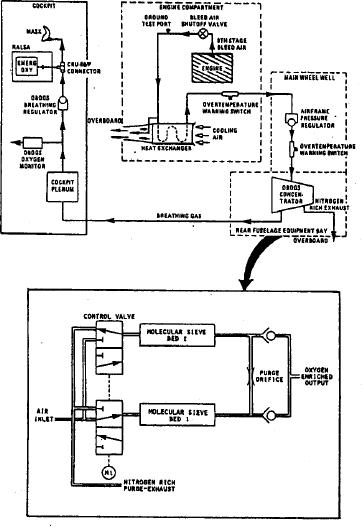
SYSTEM OPERATION
The OBOGS, shown in figure 7-21, receives engine
bleed air from the outlet of the air-conditioning heat
exchanger. The partially cooled air passes through an
air temperature sensor to a pressure reducer assembly.
The air is then routed to the concentrator. The
concentrator has a rotary valve that alternates the
airflow over the molecular sieve beds. The sieve beds
absorb the nitrogen and allow the oxygen and argon to
pass through. Two molecular sieve beds are used in the
concentrator so that while one is absorbing, the other is
desorbing (releasing) nitrogen. This method allows a
continuous flow of oxygen to the system. After the
concentrator, the oxygen flows to a plenum assembly
that acts as a surge tank and an accumulator. The
plenum also functions as a heat exchanger to heat or
cool the oxygen to approximately cockpit temperature.
Before the oxygen reaches the oxygen regulator, the
oxygen performance monitor senses the partial
pressure of the gas, and provides a signal to the pilot
whenever the pressure exceeds prescribed limits. The
oxygen then flows through the regulator to the pilot's
mask.
Q7-23.
An OBOGS system availability may be as
high as what percent?
Q7-24.
True or False. An OBOGS system has a
Figure 7-21.--Onboard oxygen generating system (OBOGS)
schematic.
reduced chance for potential accident.
Q7-25.
What are the three basic components of an
Q7-27.
During OBOGS operation, when one sieve
OBOGS system?
bed is absorbing, what is the other sieve bed
Q7-26.
What component has a built-in test?
releasing?
7-22

